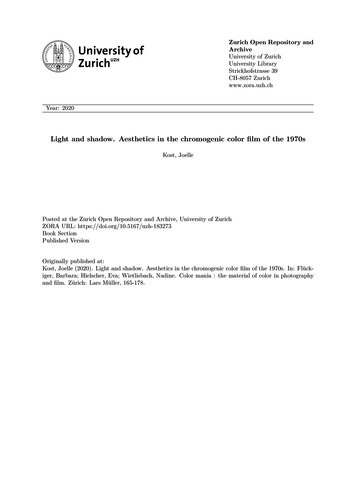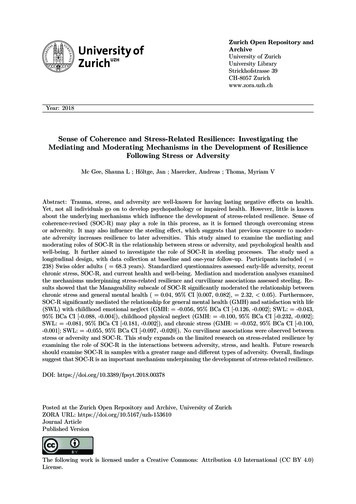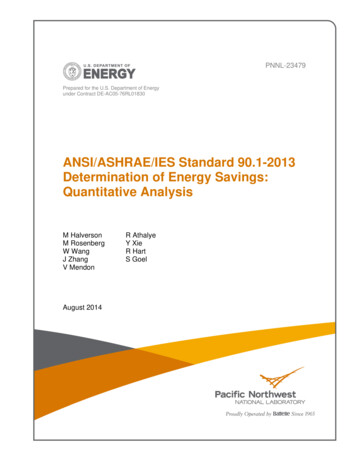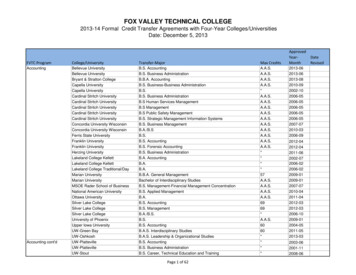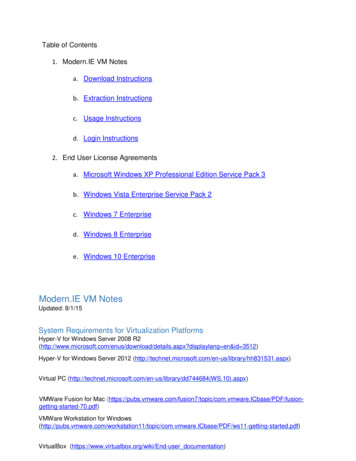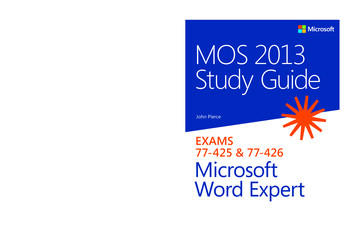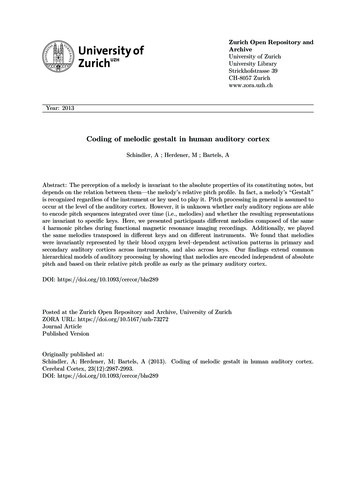
Transcription
Zurich Open Repository andArchiveUniversity of ZurichUniversity LibraryStrickhofstrasse 39CH-8057 Zurichwww.zora.uzh.chYear: 2013Coding of melodic gestalt in human auditory cortexSchindler, A ; Herdener, M ; Bartels, AAbstract: The perception of a melody is invariant to the absolute properties of its constituting notes, butdepends on the relation between them—the melody’s relative pitch profile. In fact, a melody’s “Gestalt”is recognized regardless of the instrument or key used to play it. Pitch processing in general is assumed tooccur at the level of the auditory cortex. However, it is unknown whether early auditory regions are ableto encode pitch sequences integrated over time (i.e., melodies) and whether the resulting representationsare invariant to specific keys. Here, we presented participants different melodies composed of the same4 harmonic pitches during functional magnetic resonance imaging recordings. Additionally, we playedthe same melodies transposed in different keys and on different instruments. We found that melodieswere invariantly represented by their blood oxygen level–dependent activation patterns in primary andsecondary auditory cortices across instruments, and also across keys. Our findings extend commonhierarchical models of auditory processing by showing that melodies are encoded independent of absolutepitch and based on their relative pitch profile as early as the primary auditory cortex.DOI: https://doi.org/10.1093/cercor/bhs289Posted at the Zurich Open Repository and Archive, University of ZurichZORA URL: https://doi.org/10.5167/uzh-73272Journal ArticlePublished VersionOriginally published at:Schindler, A; Herdener, M; Bartels, A (2013). Coding of melodic gestalt in human auditory cortex.Cerebral Cortex, 23(12):2987-2993.DOI: https://doi.org/10.1093/cercor/bhs289
Cerebral Cortex December e Access publication September 17, 2012Coding of Melodic Gestalt in Human Auditory CortexAndreas Schindler1, Marcus Herdener2,3 and Andreas Bartels11Vision and Cognition Lab, Centre for Integrative Neuroscience, University of Tübingen, Tübingen, Germany 2PsychiatricUniversity Hospital, University of Zürich, Zürich 8032, Switzerland and 3Max Planck Institute for Biological Cybernetics,Tübingen 72076, GermanyAddress correspondence to Andreas Bartels, Vision and Cognition Lab, Centre for Integrative Neuroscience, University of Tübingen, OtfriedMüller-Str. 25, Tuebingen 72076, Germany. Email: andreas.bartels@tuebingen.mpg.deKeywords: auditory cortex, classifiers, fMRI, melody, relative pitchIntroductionMost sounds we experience evolve over time. In accord with“Gestalt” psychology, we perceive more than just the sum ofthe individual tones that make up a melody. A temporalre-arrangement of the same tones will give rise to a newmelody, but a given melodic “Gestalt” will remain the sameeven when all pitches are transposed to a different key(Ehrenfels 1890). The stable melodic percept thereforeappears to emerge from the relationship between successivesingle notes, not from their absolute values. This relationshipis known as relative pitch and is assumed to be processed viaglobal melodic contour and local interval distances (Peretz1990). Theoretical models of auditory object analysis suggestthat the integration of single auditory events to higher-levelentities may happen at the stage of the auditory cortex(Griffiths and Warren 2002, 2004). Moreover, it has beensuggested that auditory object abstraction, that is, perceptualinvariance with regard to physically varying input properties,may emerge at the level of the early auditory cortex(Rauschecker and Scott 2009). However, so far there is nodirect experimental evidence on encoding of abstract melodicinformation at early auditory processing stages.In the present study, we used functional magnetic resonance imaging (fMRI) and variations of 2 different melodies toinvestigate pitch-invariant encoding of melodic “Gestalt” inthe auditory cortex. We expected neural response differencesto the 2 melodies to be reflected in patterns of blood oxygenlevel–dependent (BOLD) activation rather than in mean signalas both melodies were matched in terms of low-level acousticproperties. For stimulation, we used a modified version of theWestminster Chimes, as this melody is easy to recognize andsubject to general knowledge. By dividing the entire pitch sequence in half, we obtained 2 perceptually distinct melodies.Both were matched in rhythm and based on the exact same 4harmonic pitches, but differed in temporal order, that is, inmelodic Gestalt (Figs. 1 and 2). Playing both melodies on thesame instrument and in the same key allowed us to testwhether BOLD patterns represented a melody’s “Gestalt”, thatis, its relative pitch profile. In addition, to test whether relativepitch-encoding was invariant with regard to absolute pitch,we played both melodies in a different key, transposed by 6semitones. Data were analyzed using multivariate patternclassification, as this method can be used to determine statistics of activation differences but also of commonalities(Seymour et al. 2009), which would be needed to testwhether activity patterns of both melodies generalized acrossdifferent keys and instruments.Materials and MethodsParticipantsEight volunteers (all non-musicians, 7 males, 1 female) aged between24 and 37 years with no history of hearing impairment participated inthis study. All were given detailed instructions about the proceduresand provided written informed consent prior to the experiments. Thestudy was approved by the ethics committee of the University Hospital Tübingen.Auditory StimuliStimuli were generated using Apple’s Garageband and post-processedusing Adobe Audition. We employed 2 melodies, both comprising thesame 4 pitches (E4, C3, D4, and G3). Both melodies were played onpiano and flute. Additionally, for the piano we also transposed bothmelodies by 6 semitones downwards resulting in 2 additional melodies comprising 4 different pitches (A#3, F#2, G#3, and C#3). Thus,altogether our experiment involved 6 melodic conditions. We chose atransposition distance of 6 semitones as this assured that chromae ofall 4 pitches composing the transposed melodies were different fromthose played in the original key. Melodies were sampled at 44.1 kHz,matched in root-mean-square power and in duration (2 s, first 3 tones:312 ms, last tone: 937 ms; preceding silence period of 127 ms). Bothauditory channels were combined and presented centrally via headphones. Melodies were played using a tempo of 240 bpm.We performed a control experiment to rule out that any effect observed in the main experiment could be accounted for by the duration The Author 2012. Published by Oxford University Press.This is an Open Access article distributed under the terms of the Creative Commons Attribution Non-Commercial License (http://creativecommons.org/licenses/by-nc/3.0), whichpermits unrestricted non-commercial use, distribution, and reproduction in any medium, provided the original work is properly cited.Downloaded from http://cercor.oxfordjournals.org/ at Zentralbibliothek on January 29, 2014The perception of a melody is invariant to the absolute propertiesof its constituting notes, but depends on the relation between them—the melody’s relative pitch profile. In fact, a melody’s “Gestalt” isrecognized regardless of the instrument or key used to play it. Pitchprocessing in general is assumed to occur at the level of the auditory cortex. However, it is unknown whether early auditory regionsare able to encode pitch sequences integrated over time (i.e., melodies) and whether the resulting representations are invariant tospecific keys. Here, we presented participants different melodiescomposed of the same 4 harmonic pitches during functional magnetic resonance imaging recordings. Additionally, we played thesame melodies transposed in different keys and on different instruments. We found that melodies were invariantly represented bytheir blood oxygen level–dependent activation patterns in primaryand secondary auditory cortices across instruments, and alsoacross keys. Our findings extend common hierarchical models ofauditory processing by showing that melodies are encoded independent of absolute pitch and based on their relative pitch profile asearly as the primary auditory cortex.
Training Prior to ScanningTo ensure that all participants were able to recognize both melodiesregardless of key and instrument we conducted a simple 2-alternativesforced-choice melody discrimination task prior to scanning. Each participant listened to a randomly ordered sequence containing all 6melodic stimuli and pressed 1 of 2 buttons to classify the melody asmelody I or II. Participants spent 10–25 min performing this taskuntil they felt comfortable in recognizing the 2 melodies.Experimental ParadigmDuring data acquisition, stimuli were delivered binaurally at a comfortable volume level using MRI compatible headphones. For each participant, 6 runs of data were acquired, each comprising 36 stimulusblocks. Each stimulus block consisted of randomly either 5 or 6 identical melodic stimuli (each melody lasted 2 s, followed by 500 mssilence). The order of stimulus blocks was pseudo randomized andcounterbalanced such that each of the 6 stimulus conditions wasequally often preceded by all stimulus conditions. Thus, each runcomprised 6 repetitions of all 6 melodic conditions. Blocks wereseparated by silence periods of 5 s. Preceding each run, 4 dummyvolumes were acquired, and 1 randomly selected additional melodicblock was included to ensure a stable brain state after the onset ofeach run. Dummies and the initial dummy block were removed priorto analysis. The functional localizer consisted of 16 randomly selectedmelody blocks of the main experiment, each separated by silenceperiods of 12.5 s. Participants were instructed to report how often agiven melody was played within a stimulation block by pressing 1 of2 buttons of a MR compatible button box during the silence periodsafter each block (in main experiment and localizer). In the mainexperiment as well as in the functional localizer stimulation blockswere presented in a jittered fashion.Figure 2. Time-frequency spectrograms of melodic stimuli. As expected, aftertransposition to a different key systematic frequency shifts between original andtransposed melodies exist. Moreover, different distributions of harmonic powerbetween piano and flute reflect their difference in timbre.of the last tone that was longer than the preceding 3 in all melodicsequences (c.f. Fig. 1). In the control experiment the durations of alltones were matched, with the same duration as the first 3 (312 ms) ofthe initial experiment.2988 Coding of Melodic Gestalt in Human Auditory Cortex Schindler et al.fMRI Preprocessing and Univariate AnalysisAll neuroimaging data was preprocessed using SPM5 (http://www.fil.ion.ucl.ac.uk/spm/). Functional images were corrected for slice acquisition time, realigned to the first image using an affine transformationto correct for small head movements and EPI distortions were unwarped, and spatially smoothed using an isotropic kernel of 3-mmfull width at half-maximum. Preprocessed images of each run werescaled globally, high pass filtered with a cutoff of 128 s, and convolved with the hemodynamic response function before entering ageneral linear model with one regressor of interest for each stimulusblock. Additionally, regressors for SPM realignment parameters andthe mean signal amplitude of each volume obtained prior to globalscaling were added to the model. For the sound localizer a generallinear model was fitted involving one regressor for the melody blocksand one regressor for the silence periods. Used as a univariate featureDownloaded from http://cercor.oxfordjournals.org/ at Zentralbibliothek on January 29, 2014Figure 1. Melodies in piano-roll notation. Both stimuli are shown in the original keyas well as in the transposed version, 6 semitones lower. Note that in the transposedcondition all 4 pitches comprise different chromae as compared with the original key.A behavioral experiment prior to fMRI scanning assured that all participants wereable to distinguish between both melodies.fMRI MeasurementsFor each participant 6 experimental runs containing 343 volumeswere acquired, plus 1 run for a separate sound localizer comprising226 volumes. Functional data were recorded on a Siemens 3T TIMTrio scanner using a T2*-weighted gradient echo-planar imaging (EPI)sequence. Functional images were acquired using a low-impact-noiseacquisition fMRI sequence, which increases the dynamic range of theBOLD signal in response to acoustic stimuli (Seifritz et al. 2006).In short, this sequence elicits a quasi-continuous acoustic gradientnoise that induces less scanner-related BOLD activity compared withconventional EPI sequences (which induce increased levels of auditory baseline activity due to their pulsed scanner noise). Functionalvolumes were acquired using the following parameters: Gradient recalled echo-planar acquisition sequence with 18-image slices, 3-mmslice thickness, 2100 ms volume time of repetition, 20 20 cm field ofview, 96 96 matrix size, 48 ms echo time, 80 flip angle, 1157 Hzbandwidth, resulting in-plane resolution 2.1 2.1 mm2. Slices werepositioned such that the temporal cortex including Heschl’s gyrus(HG), superior temporal sulcus (STS), and superior temporal gyrus(STG) was fully covered. For each participant, a structural scan wasalso acquired with a T1-weighted 1 1 1 mm3 sequence.
selection for further multivariate analysis, the t-contrast “sound versussilence” allowed us to independently rank voxels according to theirresponse sensitivity to melodic stimuli [see Recursive Feature Elimination (RFE) methods].Discriminative Group MapsTo examine the spatial consistency of the discriminative patternsacross participants, group-level discriminative maps were generatedafter cortex-based alignment of single-participant discriminative maps(Fischl et al. 1999). For a given experiment, the binary singleparticipant maps were summed up, and the result was thresholdedsuch that only vertices present in the individual discriminative mapsof at least 5 of the 8 participants survived. A heat-scale indicates consistency of the voxel patterns distinguishing a given experimental condition pair in that the highest values correspond to vertices selectedby all participants. As each individual discriminative map only contributes voxels that survived the recursive feature elimination, thisgroup map can be interpreted as a spatial consistency measure acrossparticipants.Tests for Lateralization BiasesTo detect possible lateralization biases we tested classification performances from left and right hemispheres against each other on thegroup level using a one sample t-test. Additionally, we tested for apossible hemispheric bias during selection of discriminative voxels bythe RFE analysis that involved data of both hemispheres. To this end,we compared the numbers of discriminative voxels within each hemisphere across the group. For each participant and classification, wecalculated the lateralization index as the difference between thenumber of voxels of left and right hemisphere divided by the numberof voxels selected in both hemispheres. A lateralization index of 1 or 1 thus means that all voxels selected by the RFE fell into 1 hemisphere. An index of 0 indicates that there was no lateralization at all.We then tested for systematic lateralization biases across the group.For generalization across keys and instruments voxel counts of bothclassification cycles (see RFE methods) were combined.ResultsDe-coding Melodies From Voxel PatternsInitially, we examined whether both melodies, played in thesame key and on the same instrument could be distinguishedby their corresponding BOLD patterns. We trained the classifier separately on piano or flute trials, respectively, andapplied a leave-one-out cross-validation approach across runsto test the classifier on independent runs (see Materials andMethods). Within both instruments melodies were classifiedsignificantly above chance ( piano: 0.65, P 1.22 10 05;and flute: 0.63 P 4.08 10 05; 1-tailed t-test, n 8), indicating that the BOLD patterns were melody-specific for thesestimuli (see Fig. 3A). To illustrate the anatomical consistencyof discriminative voxel populations across participants wegenerated a group-level map showing only voxels thatcoincided anatomically in at least 5 out of 8 participants.Cerebral Cortex December 2013, V 23 N 12 2989Downloaded from http://cercor.oxfordjournals.org/ at Zentralbibliothek on January 29, 2014Multivariate Pattern AnalysisPreprocessed functional data were further analyzed using custom software based on the MATLAB version of the Princeton MVPA olbox/). Regressor betavalues (one per stimulus block) from each run were z-score normalized and outliers exceeding a value of 2 standard deviations were setback to that value. Data were then used for multivariate pattern analysis employing a method that combines machine learning with aniterative, multivariate voxel selection algorithm. This method was recently introduced as “RFE” (De Martino et al. 2008) and allows theestimation of maximally discriminative response patterns without an apriori definition of regions of interest. Starting from a given set ofvoxels a training algorithm (in our case a support vector machinealgorithm with a linear kernel as implemented by LIBSVM (http://www.csie.ntu.edu.tw/ cjlin/libsvm/) discards iteratively irrelevantvoxels to reveal the informative spatial patterns. The procedure performs voxel selection on the training set only, yet increases classification performance of the test data. The method has proved to beparticularly useful in processing data of the auditory system (Formisanoet al. 2008; Staeren et al. 2009). Our implementation was the following:In a first step, beta estimates of each run (one beta estimate per stimulus block/trial) were labeled according to their melodic condition (e.g.,melody I played by flute). Within each participant and across all runs,this yielded a total of 36 trials for each melodic condition. Subsequently, BOLD activation patterns were analyzed using the LIBSVMbased RFE. For each pair of melodic conditions (e.g., both melodiesplayed by flute), trials were divided into a training set (30 trials percondition) and a test set (6 trials per condition), with training and testsets originating from different fMRI runs. The training set was used forestimating the maximally discriminative patterns with the iterativealgorithm; the test set was only used to assess classification performance of unknown trials (i.e., not used in the training).All analyses started from the intersection of voxels defined by ananatomically delineated mask involving both hemispheres (includingtemporal pole, STG, STS, and insula, Supplementary Material) andsound responsive voxels identified in the separate localizer experiment (t-contrast sound vs. silence). Voxels falling into the anatomicalmask were ranked according to their t-values and the most responsive2000 were selected. Compared with recent studies employing RFE incombination with auditory fMRI data, a starting set of 2000 voxels isstill the upper limit for this type of analysis (De Martino et al. 2008;Formisano et al. 2008; Staeren et al. 2009). Due to noise, in largevoxel sets the RFE method is prone to incorrectly labeling potentiallyinformative voxels with too low weights, thus discarding them earlyin the iteration cycle, which ultimately leads to suboptimal classification of the test-set. To minimize this problem, we needed to furtherpreselect the voxel set prior to RFE, which we wanted to do on thebasis of classifier performance (within the training set) rather than ont-values alone. To this end, we stepwise carried out cross-validated(leave-one-run-out) classifications and removed each time the 4%voxels with the lowest t-values obtained in the sound-localizer.Similar to the RFE approach, we subsequently selected the voxel setwith the peak classification accuracy for further analysis. In contrastto RFE; however, we still used each voxel’s sound-responsiveness (assessed by the functional sound localizer) as its discard criterion andthus avoided the rejection of potentially informative data by noisedriven low SVM weights. This initial feature selection procedure didnot involve any testing data used for the subsequent RFE but exclusively independent data. We set the stop criterion of the initial featureselection method at 1000 voxels to get a lower voxel limit for the RFEanalysis as employed previously (Staeren et al. 2009). The final voxelpopulation on which the RFE analysis started ranged therefore from2000 to 1000 voxels. We employed 6 cross-validation cycles, each involving different runs for training and testing. For each of these crossvalidations, 10 RFE steps were carried out, each discarding 40% ofvoxels. Crucially, classification performance of the current set ofvoxels was assessed using the external test set. The reported correctness for each binary comparison was computed as an average acrossthe 6 cross-validations. Single-participant discriminative maps corresponded to the voxel-selection level that gave the highest average correctness. These maps were sampled on the reconstructed cortex ofeach individual participant and binarized.To compare classification performances between left and righthemispheres, we additionally ran the same RFE analysis on eachhemisphere separately. To match the number of starting voxels withthose of the analysis involving both hemispheres, we separatelydefined the anatomical region of interest (ROI) for each hemisphereand also ranked voxels separately for a given hemisphere accordingto its statistical t-values in the sound localizer map. Thus, also withineach hemisphere, the final voxel population on which further analysisstarted ranged from 2000 to 1000 voxels.
Figure 4A and Supplementary Figure S1 show that the mostconsistent discriminative voxel patterns span bilaterally fromlateral HG into the Planum Temporale (PT).Figure 4. Multiparticipant consistency maps of discriminative voxels shown on astandard brain surface of the temporal lobes. The yellow outline illustrates theanatomically defined region of interest from which all analyses started from. All groupmaps were created by summation of the individual discriminative voxel maps of all 8participants. Each map was thresholded such that a voxel had to be selected in atleast 5 individuals to appear on the group map. Color coding indicates consistencyacross participants. Across all classifications no lateralization bias was found (c.f.Supplementary Table S1). For group map of melody classification on piano seeSupplemental Figure S1.2990 Coding of Melodic Gestalt in Human Auditory Cortex Schindler et al.Tests for Lateralization Effects Between Left and RightHemispheresTo examine potential lateralization effects in coding ofmelodic “Gestalt”, we compared the classification performances obtained during separate analysis of left andright hemispheric ROIs. This however did not reveal anysystematic differences between hemispheres [2-tailed t-test;Melody Classification t(15) 0.52, P 0.61; Instrumentst(7) 0.04, P 0.97; Keys t(7) 0.81, P 0.45; c.f. Supplementary Figure S2]. Moreover, we tested for a potential selectionbias during RFE analysis on the joint ROI with voxels of bothhemispheres. However, this analysis also did not reveal anysystematic preference towards either hemisphere; that is,voxels of both hemispheres were equally likely to be selectedduring RFE (2-tailed t-test; Melody Classification t(15) 0.09,P 0.93; Instruments t(7) 0.89, P 0.40; Keys t(7) 0.89,P 0.40; c.f. Supplementary Table S1).In a last step, using a subset of 5 of our 8 participants, weexamined whether the duration of the last tone (which waslonger than the remaining 3) could have affected our results.Note that this would have been relevant only forDownloaded from http://cercor.oxfordjournals.org/ at Zentralbibliothek on January 29, 2014Figure 3. De-coding results based on fMRI voxel patterns of early auditory cortex.(A) Performance of classification between melodies, tested separately on 2 instruments.(B) Classification performance between melodies played on different instruments anddifferent keys. All results were confirmed using a sub-sample of 5 participants andadapted versions of our melodic stimuli where all pitches were of matched duration(Supplementary Table S2). *P 0.05, Bonferroni corrected for 4 comparisons.Invariance to Instrument and KeyTo examine the influence of timbre on melody classification,in a next step, we trained the classifier to distinguish both melodies played on one instrument and tested it using the melodies played on the other instrument. To assure that eachinstrument was once used for training and once for testing,classification was conducted twice and accuracies of bothturns were averaged. Figure 3B shows classification resultsacross instruments. Despite substantial differences in energydistribution and frequency spectra between both instruments,this classification also succeeded significantly above chance(0.58, P 6.28 10 05; 1-tailed t-test, n 8). Again, the inspection of the corresponding discriminative group maps revealeda distribution of discriminative voxels that is consistentwith our previous results, spanning bilaterally in HG and PT(Fig. 4B).Subsequently, we examined whether BOLD activation patterns preserved melody-specific information across differentkeys. Note that after transposition, the only common propertythat characterized the 2 melodies as identical was their relative change in pitch height evolving over time, that is, itsmelodic “Gestalt”. We trained the classifier on both melodiesplayed in one key and tested it on the same melodies transposed by 6 semitones to a different key (see MaterialsMethods). To use both keys once for testing and once fortraining we again conducted this classification twice and averaged both performances. Figure 3B shows that classificationacross keys (0.58, P 2.60 10 04; 1-tailed t-test, n 8) succeeded significantly above chance. This implies that BOLDpatterns do not only represent differences in absolute pitchbut that they also code for relative pitch, that is, informationthat is necessary for the concept of melodic “Gestalt”. Theinspection of the corresponding discriminative group mapsrevealed a distribution of discriminative voxels spanning bilaterally in HG and PT (Fig. 4C).
distinguishing non-transposed melodies, as for the transposedoneslow-level pitch information could not have provided discriminative cues. In any case, we were able to replicate all resultswith similar de-coding performances using adapted melodieswith matched duration of all pitches (SupplementaryTable S2).DiscussionWe examined neural representations of melodic sequences inthe human auditory cortex. Our results show that melodiescan be distinguished by their BOLD signal patterns as early asin HG and PT. As our melodies differed only in the sequence,but not identity of pitches, these findings indicate that thetemporal order of the pitches drove discriminative patternFigure 5. (A) Spatial overlap between the cytoarchitectonically defined PAC (areasTe 1.0, 1.1, and 1.2, probabilistic threshold: 30%) and an average group map ofdiscriminative voxels for all melody classifications (B). Substantial overlap existsbetween our results and areas Te.Cerebral Cortex December 2013, V 23 N 12 2991Downloaded from http://cercor.oxfordjournals.org/ at Zentralbibliothek on January 29, 2014Localizing Human Primary Auditory CortexTo provide an objective measure for the extent of overlapbetween discriminative voxels and the anatomical location ofprimary auditory cortex (PAC), we related our results to thehistologically defined areas Te1.0, Te1.1, and Te1.2 (Morosanet al. 2001). Figure 5A shows all 3 of these areas (at a probability threshold of 30%) on the standard surface used for allgroup analyses in this study. There was a close overlapbetween all cytoarchitectonically defined primary regions andthe anatomical landmarks of HG. To directly compare the 3anatomically defined core regions with our results, we showtheir common outline on top of an average of all group mapsobtained by all classifications of the 2 melody conditions(Fig. 5B). Even though substantial parts of this map extend toPT, there is a high degree of agreement between the histologically defined PAC and the average discriminative voxel-maps.formation. Importantly, our results show that the voxel patterns were diagnostic for melodies also when they wereplayed on different instruments, and even when they weretransposed by 6 semitones into a different key. Our findingstherefore suggest that melodic information is represented asrelative pitch contour, invariant to low-level pitch or timbreinformation, in early auditory cortex.By definition, a melody consists of several pitches, integrated across time. Previous evidence points towards a role ofa region anterior to HG in the processing of pitch changes.Activity in this area was found to correlate with the amountof frequency change over time (Zatorre and Belin 2001).Equally, univariate contrasts between melodic stimuli (simplydefined as variations of pitch over time) and frequencymatched noise, fixed pitch (Patterson et al. 2002) or silence(Brown et al. 2004) did activate this area. However, univariatecontrasts between different melodic excerpts (i.e., random vs.diatonic melodies), did not lead to differential activation thereor in any other brain area (Patterson et al. 2002). Thus, therole of regions anterior to HG in differential melody encodingremains elusive. Since some voxels anterior to HG were alsoactive in our sound localizer
Stimuli were generated using Apple's Garageband and post-processed using Adobe Audition. We employed 2 melodies, both comprising the same 4 pitches (E4, C3, D4, and G3). Both melodies were played on . Dummies and the initial dummy block were removed prior to analysis. The functional localizer consisted of 16 randomly selected
